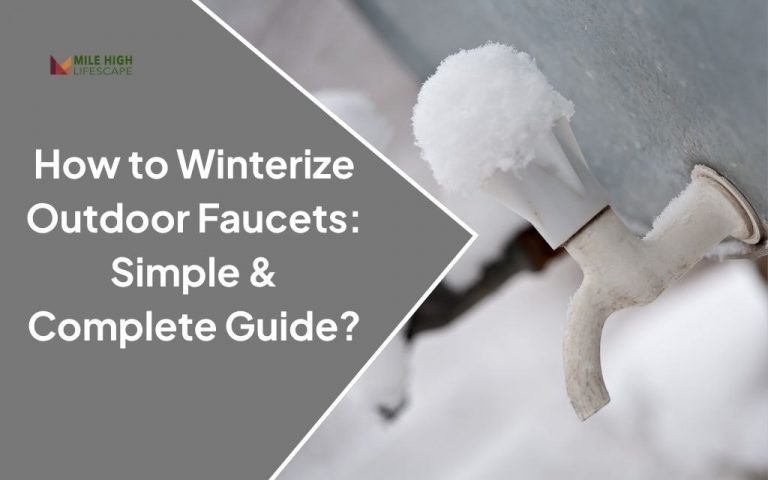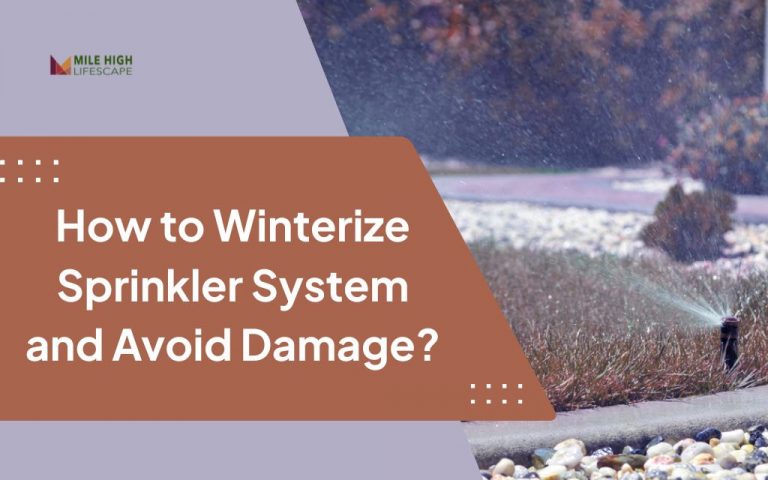What happens if you apply fertilizer to wet grass? Applying fertilizer to wet grass often creates problems that can damage your lawn rather than help it grow.
Timing fertilizer application represents one of the most critical yet overlooked aspects of effective lawn care in the Front Range region. The moisture content of both your grass blades and soil dramatically impacts nutrient absorption, distribution efficiency, and the overall health outcomes for your lawn.
Let’s explore why timing matters when feeding your lawn and how to navigate fertilization in Denver’s unique climate to achieve optimal results without wasting resources or damaging your turfgrass investment.
What Happens If You Apply Fertilizer to Wet Grass?
Applying fertilizer to wet grass introduces several lawn care challenges that can undermine your efforts to maintain a healthy yard:
Fertilizer Sticks to Wet Blades
When grass blades hold moisture, fertilizer granules adhere to them instead of falling to the soil. This direct contact creates a concentrated exposure to nitrogen and other nutrients. The result?
Chemical burns that damage cell structures, leaving unsightly yellow or brown patches throughout your lawn. Denver’s intense sunlight amplifies this burning effect, particularly at our higher elevation.
Uneven Distribution Problems
Walking across wet turf while spreading fertilizer creates dual problems. First, your footprints compress already saturated soil, creating compaction that restricts root growth.
Second, your movement disrupts normal granule distribution, causing fertilizer to clump in certain areas while leaving others undernourished. This leads to a streaky growth pattern where some sections grow lush while others remain stunted.
Increased Runoff Risk
Denver’s varied topography includes many properties with slopes and grade changes. When you apply fertilizer to wet grass on these inclines, water carries nutrients downhill before they can penetrate the soil.
This movement not only wastes your lawn care investment but also sends concentrated chemicals into local watersheds, contributing to environmental issues like algae blooms in our waterways.
Soil Absorption Challenges
Wet soil already contains maximum moisture, leaving limited capacity to absorb fertilizer solutions. Rather than penetrating to root zones where nutrients provide benefits, fertilizer remains near the surface or creates pooling in low areas.
This superficial distribution promotes weed growth more effectively than it nourishes your desired turfgrass.
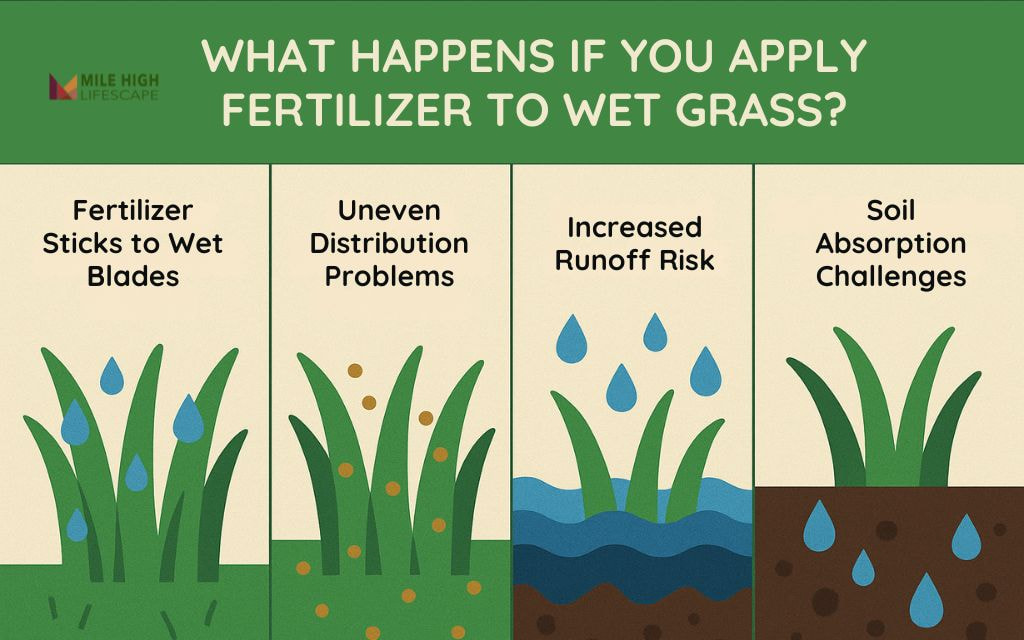
When Moisture Isn’t Always Problematic
Despite these concerns, certain moisture scenarios pose fewer risks:
- Morning Dew: Light dew differs significantly from truly wet conditions. This minimal moisture can sometimes help granular products make initial soil contact without causing the negative effects associated with saturated grass.
- Specific Fertilizer Types: Some liquid fertilizers with specialized formulations actually perform better with slight moisture present. These products use surfactants designed to work with minimal water for proper soil penetration.
- Professional Applications: Lawn care specialists use calibrated equipment and specialized techniques that can sometimes overcome the challenges of slightly damp conditions, though they still prefer optimal dry blade scenarios.
What If It Rains After Applying Lawn Fertilizer?
Denver’s afternoon thunderstorms catch many homeowners by surprise after morning yard work. When rain follows fertilization, outcomes vary based on timing, intensity, and the fertilizer type you’ve applied:
| Scenario | Impact | What to Do |
| Light rain within 8 hours | Helps water in the fertilizer | Continue with normal lawn maintenance |
| Moderate rain after 24 hours | Ideal timing for absorption | Your fertilizer is now fully activated |
| Heavy rain within 2–3 hours | Risk of runoff or leaching | Monitor for pooling or streaking patterns |
| Prolonged downpour on sloped yard | Likely washed away | Consider reapplication in 7–10 days |
Denver’s higher elevation creates unique considerations. Granular fertilizers remain more vulnerable to being washed away than liquid formulations. For our climate, slow-release formulas provide better protection against unexpected rain events and reduce the chance of nutrient loss.
If you notice fertilizer granules washed onto sidewalks or driveways, sweep them back onto the lawn to prevent them from entering storm drains and polluting local water systems.
Best Practices for Fertilizing Your Lawn in Denver
- Apply fertilizer when grass blades are dry but soil remains slightly moist—ideally 24 hours after watering or a light rain.
- Select slow-release fertilizer formulations, which resist immediate dissolution and reduce burn risks in our intense mountain sunlight.
- Mow your lawn 1-2 days before fertilizing, never immediately after. This allows proper distribution and prevents cutting away products that haven’t been absorbed.
- Water lightly after applying granular fertilizer unless the soil already contains adequate moisture. This helps move nutrients to the root zone.
- Check weather forecasts carefully – avoid fertilizing if precipitation appears in the forecast within 24 hours.
- Schedule application during cooler parts of the day (early morning or late afternoon) to reduce evaporation and maximize absorption.
- Use a calibrated spreader for even coverage that prevents clumping on grass blades.
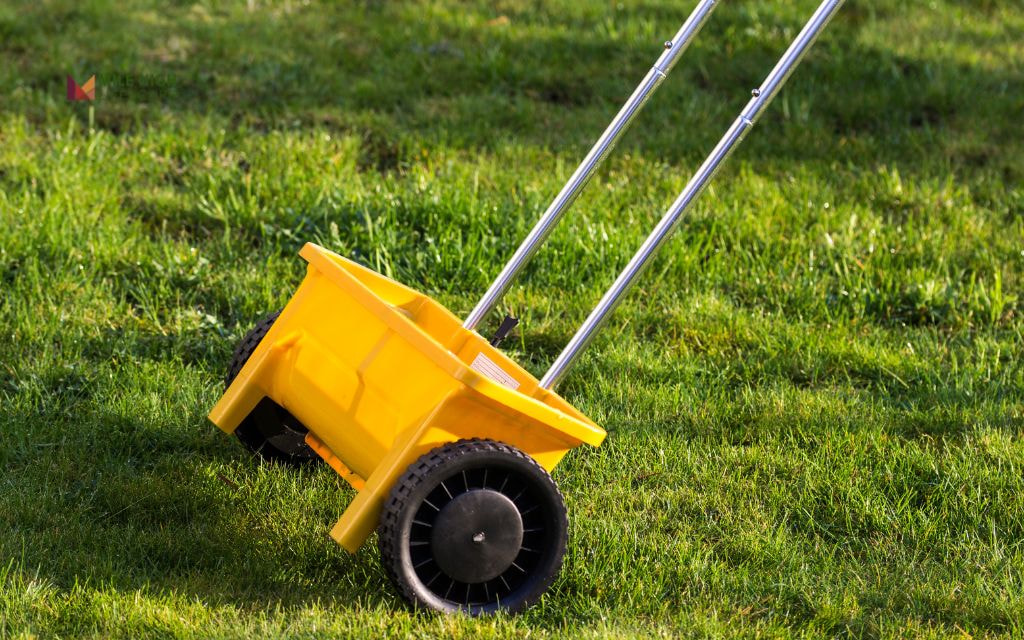
How Much Fertilizer Should I Apply?
Understanding Application Rates
Most Denver lawns require 3-4 pounds of nitrogen per 1,000 square feet annually. Divide this into multiple applications of approximately 1 pound of nitrogen per 1,000 square feet each time.
Check your fertilizer’s NPK ratio (the three numbers on packaging) to calculate the correct amount – a 20-0-10 product needs 5 pounds to deliver 1 pound of actual nitrogen.
Denver-Specific Adjustments
Reduce spring application rates by 15-20% to prevent surge growth at our elevation. Increase fall applications slightly to support root development during our extended growing season, which often continues into October.
Measure Accurately
Calculate your exact lawn square footage by measuring rectangular sections and subtracting non-turf areas. Many homeowners overestimate, leading to excess application and runoff issues.
Calibrate Your Spreader
Test your spreader with a known quantity of fertilizer on a measured 1,000 square foot section to ensure accurate delivery rates. Document settings for future consistency.
Split Applications
For Denver lawns, divide annual applications into:
- 25% in early spring (April-May)
- 25% in early summer (June)
- 50% in fall (September-October)
This schedule aligns with natural growth cycles while accounting for our climate conditions.
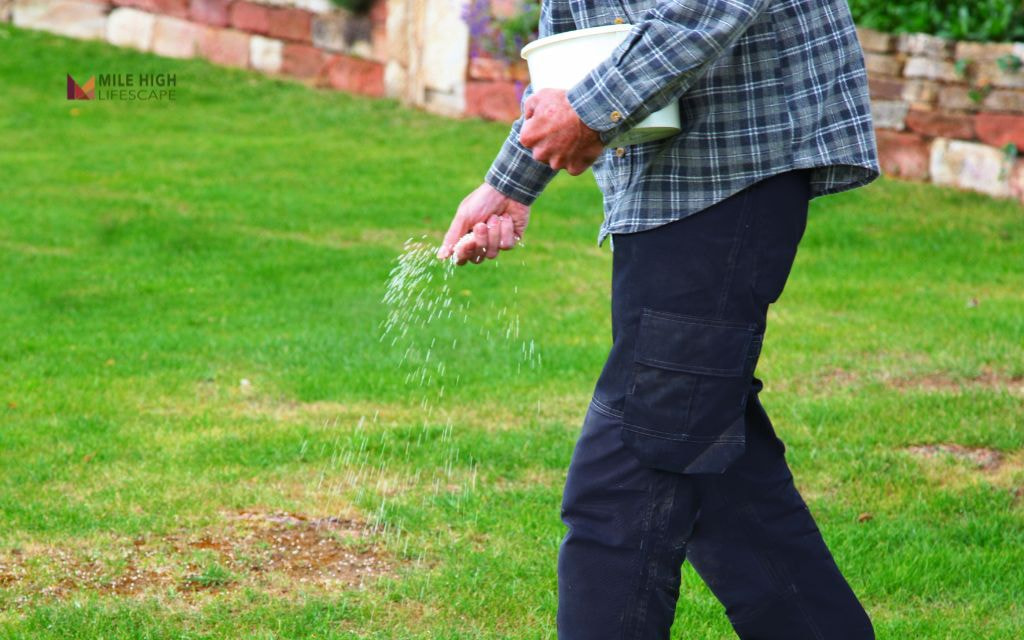
What to Do If You Already Fertilized Wet Grass
If you’ve already applied fertilizer to wet grass, implement these recovery steps:
- Wait 24-48 hours before additional watering if you suspect potential leaf burn. This gives fertilizer time to move off blades and into soil.
- Monitor your lawn for yellowing patches or streaking that might indicate uneven distribution or chemical burn.
- Apply a light watering if conditions remain dry to help dissolve and distribute remaining surface granules.
- Avoid immediate reapplication even if you suspect runoff occurred—this increases the risk of over-fertilization.
- For seriously damaged areas, plan to reseed in early fall when Denver’s temperatures create ideal germination conditions.
Conclusion
While light moisture like morning dew won’t ruin your fertilization efforts, thoroughly wet grass creates significant challenges for effective lawn nutrition. The key factors for success include proper timing, application method, and selecting fertilizer types formulated for our regional conditions.
Denver’s altitude, soil composition, and unpredictable weather patterns create unique lawn care challenges. For a personalized fertilization schedule that accounts for your specific grass type and microclimate, contact Mile High Lifescape.
Our lawn care experts understand the local growing conditions and can develop a maintenance plan that produces results without wasting resources.
Frequently Asked Questions (FAQs)
Can you apply fertilizer when grass is wet?
For optimal results, avoid applying fertilizer when grass blades retain moisture. Wet conditions lead to uneven distribution, increased runoff potential, and can damage your lawn through direct contact with concentrated nutrients. Wait for blades to dry completely while maintaining slight soil moisture for best results.
Can I put fertilizer down after it rains?
Wait until grass blades dry completely after rainfall, even if the soil remains moist. This ideal condition – dry blades with damp soil – creates perfect conditions for fertilizer absorption without the risks associated with wet application.
When should you not apply lawn fertilizer?
Avoid fertilizing during extreme heat periods, drought conditions, heavy rain forecasts, or when your lawn enters dormancy. These situations reduce effectiveness and increase the potential for lawn damage or environmental impact.
What is too much rain for fertilizer?
Sustained rainfall exceeding half an inch within 24 hours of application typically causes significant runoff issues. In Denver’s often intense summer storms, even 15 minutes of heavy precipitation can compromise fertilizer effectiveness on sloped yards.
Can you fertilize with dew on grass?
Light morning dew presents minimal problems compared to genuinely wet grass. However, for best results, wait until the sun dries the lawn surface while the soil beneath remains slightly moist from the dew’s moisture.


